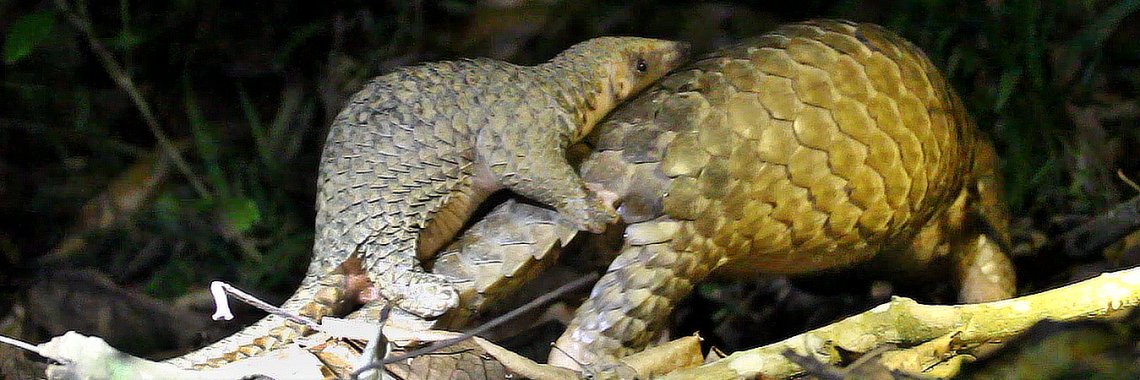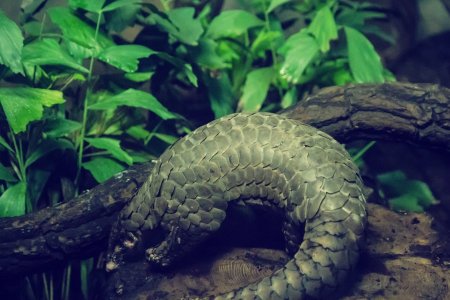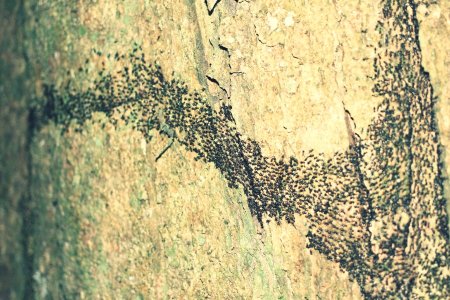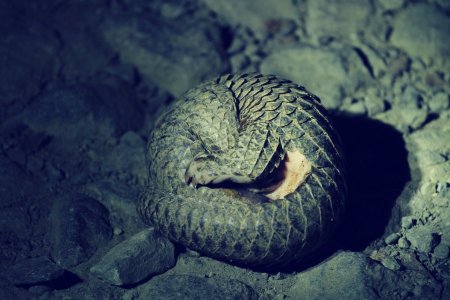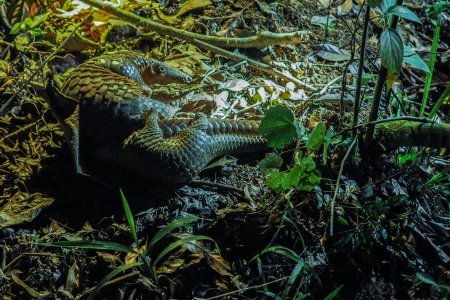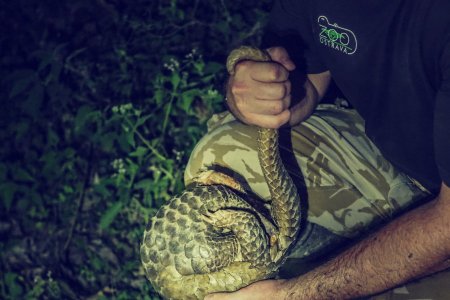Pangolins (Pholidota) represent an evolutionarily unique order of remarkable mammals related to carnivores that have lived on planet Earth for about 65 million years. They are mostly nocturnal, secretive creatures specializing in hunting ants and termites. They are perfectly adapted to this way of obtaining food - they dig up their prey and hunt with strong claws and an extremely long sticky tongue. As the only mammals in the world, they have their
bodies covered in scales. They use them for defence, in which they curl into a firm and almost impenetrable ball (hence the name “pangolin”, which originated from the Malaysian word “penggulung”, i.e. something that rotates). There are currently 8 species of pangolins, 4 of which live in Asia and 4 in Africa. Depending on the species, they can be about 30-100 cm (without tail) long and can reach a weight of 2-35 kg, with males tending to be up to half as large as females. Some species are adapted to tree climbing, others are purely terrestrial. However, all species are threatened in the wild.
Mainly because of their unique scales, pangolins have been driven to the brink of extinction. Although these scales were formed by the transformation of hairs and thus just like hairs, nails, claws, or hooves of other mammals consist of keratin, there is a great demand for them from humans. Some traditional Asian and African cultures believe in their alleged magical and healing effects. Although there is no research to confirm their medicinal effect, people believe that the powder from pangolin scales cures skin and venereal diseases, supports blood circulation and lactation, treats swelling, asthma, abscesses, rheumatism, arthritis, and relieves menstrual pain. In addition, pangolins are also consumed - in Asia as a luxury delicacy, in Africa mainly as bushmeat. With their defensive strategy of curling into a tight ball, pangolins are able to defend themselves even against the attack of large felines, but unfortunately, this strategy is completely ineffective in defending against poachers.
It is because of their scales that pangolins are unique among mammals
All pangolins have been protected species since 1975, when they were included in CITES Appendix II (Convention on International Trade in Endangered Species of Wild Fauna and Flora). In 2000, zero quotas were announced for trade in Asian species, which, on the other hand, caused an increase in the rate of poaching of African species. In 2016, in response to the critical situation, all species of pangolins were reclassified to CITES Appendix I, and therefore international trade in pangolins or parts of their bodies is now prohibited. Nevertheless, it is estimated that over a million pangolins have been poached in the last 10 years. This means that every 5 minutes, one pangolin disappears from the wild. In the last 5 years or so, the frequency of confiscated consignments of smuggled pangolin bodies and scales has increased significantly, as has the volume of these consignments. Pangolins are currently considered the most smuggled mammals in the world.
You can find more about the illegal trade in pangolins on the Stolen Wildlife campaign website.
Taxonomy of pangolins
Asian species:
Sunda pangolin (Manis javanica) - Critically Endangered
Chinese pangolin (Manis pentadactyla) - Critically Endangered
Philippine pangolin (Manis culionensis) - Critically Endangered
Indian pangolin (Manis crassicaudata) - Endangered
African species:
White-bellied pangolin (Phataginus tricuspis) - Endangered
Giant pangolin (Smutsia gigantea) - Endangered
Temminck’s pangolin (Smutsia temminckii) - Vulnerable
Long-tailed pangolin (Phataginus tetradactyla) - Vulnerable
Sunda Pangolin
Distribution
The area of occurrence of the Sunda pangolin (Manis javanica) is in Southeast Asia from Myanmar to Vietnam, the Malay Peninsula and the Indonesian islands of Sumatra, Java and Borneo. It lives secretly in various types of habitats, from primary and secondary rainforests, through grassy and bushy areas to plantations and agricultural lands close to human settlements.
Diet
The Sunda pangolin, like most other species of pangolins, is a specialist in hunting ants and termites. However, it also feeds on ant larvae, bee pupae, flies, worms, crickets and larvae of other insects. An adult pangolin is able to consume about 70 million insects a year, thanks to which pangolins can significantly regulate the number of these invertebrates in the environment. Despite the fact that the Sunda pangolin moves mainly on the ground, a considerable part of its hunting activities take place on trees.
Ants and termites make up the bulk of the pangolin diet
Anatomy
Pangolins are completely toothless, but they use their sticky tongue, which is even longer than their body, very well for hunting their prey. They get to insects in the soil or wood thanks to their powerful claws. Their semi-prehensile tail allows them to move in branches.
Most of the pangolin body, with the exception of the abdomen, is covered by hard keratin scales. It is this unique scaly “armour” of pangolins that protects not only against attacks of their prey but in the case of the typical defensive curling of the body into a ball also against attacks of predators. Scales of this species are predominantly dark brown in colour, although individuals with white scales on the tail are often found. The cause of this phenomenon has not yet been clarified. As with other pangolins, the scales of the young are soft and light, but after birth they begin to gradually harden and darken. An estimated 900-1,000 scales can be counted on the Sunda pangolin body.
Pangolin in its typical defensive position - curled into a ball
Mating and reproduction
Pangolins live most of the time solitary, they only meet for mating. The breeding season lasts more or less all year round. After about 6 months of pregnancy, the female usually gives birth to 1 pup, which she then nurses for about 3-4 months. However, just one month after birth, pups are able to consume even ants and termites. From about this age, as in other species of pangolins, the female carries the pup on the base of her tail in search of food. The young stay with their mother until about two years of age when they reach sexual maturity. The female home range size was estimated at about 7 ha, in the case of males at about 40 ha. They are territorial, with males marking their territory with urine and faeces.
Female carries the young on the base of her tail
Behaviour
The Sunda pangolin, like most pangolin species, is secretive, solitary and active at night. For sleep during the day, taking rest and for caring for the offspring, it digs its own burrows, or uses burrows created by other animals. However, it also sleeps in tree cavities or fallen trunks. Pangolins not only regulate insect populations, but also by digging up the soil for food or rest, they help aerate the soil, facilitate the nutrient cycle, and thus play an important role in the ecosystem. In addition, this species, like other pangolins, is a capable swimmer.
In the event of danger, pangolins can resist by hissing, snorting, spraying smelly fluid from the gland at the anus, and flicking their sharp tail. However, their main defense strategy is to roll the body into a tight ball, in which they cover their head and soft, vulnerable abdomen with their tails.
Pangolin is a predominantly nocturnal, secretive animal
Threats
According to the IUCN Red List of Threatened Species, the Sunda pangolin is one of the three critically endangered pangolin species. Due to the secretive, mostly nocturnal way of life, estimates of the size of its populations are not yet known, and further research is needed. However, the volume of the international trade originating in Indonesia over the last few decades suggests that the local pangolin population is declining dramatically. Likewise, in other countries of its occurrence, the Sunda pangolin is already a very rare species. Hunters in many of these countries acknowledge that pangolins have declined dramatically over the past few decades as a result of hunting, especially since about 1990 when the commercial trade in pangolins began to escalate. This is the main cause of them being threatened. This is despite the fact that the Sunda pangolin, together with other pangolin species, is listed in CITES Appendix I and is protected in virtually all countries of its occurrence, including Indonesia (in Indonesia, it is an absolutely protected species whose possession, killing or trafficking is punishable by up to 5-year imprisonment and a fine of up to USD 7,500).
In Indonesia, the Sunda pangolin is still hunted for local use on the island of Kalimantan. Traditional medicine practitioners in Indonesia still recommend pangolin scale products for the treatment of heart disease and skin problems. Above all, however, there is an extensive illegal trade in pangolins from Indonesia, mostly from Sumatra, mainly to China and Vietnam. There is evidence of professional commercial hunting of this species both in Sumatra and more widely in Indonesia, purely for the purpose of commercial illegal international trade. Prior to 2000, this trade largely involved the export of pangolin skins to North America (e.g. for the production of special cowboy boots, etc.), but in the last two decades, these have been live pangolins, their scales, and meat primarily intended for China and Vietnam. According to an estimate by a TRAFFIC’s study (2017), 10,000 pangolins are poached in Indonesia every year.
Other threats include the natural environment loss, largely due to commercial activities such as logging, mining, and hydropower and road construction, which has facilitated hunting and poaching by opening up previously inaccessible areas. However, the severity of the threats to pangolins due to the loss of their natural environment is not well described because of their ability to survive in a man-altered landscape. The ability of this species to persist in habitats such as oil palm and rubber plantations for a long time is unknown and requires further research.




